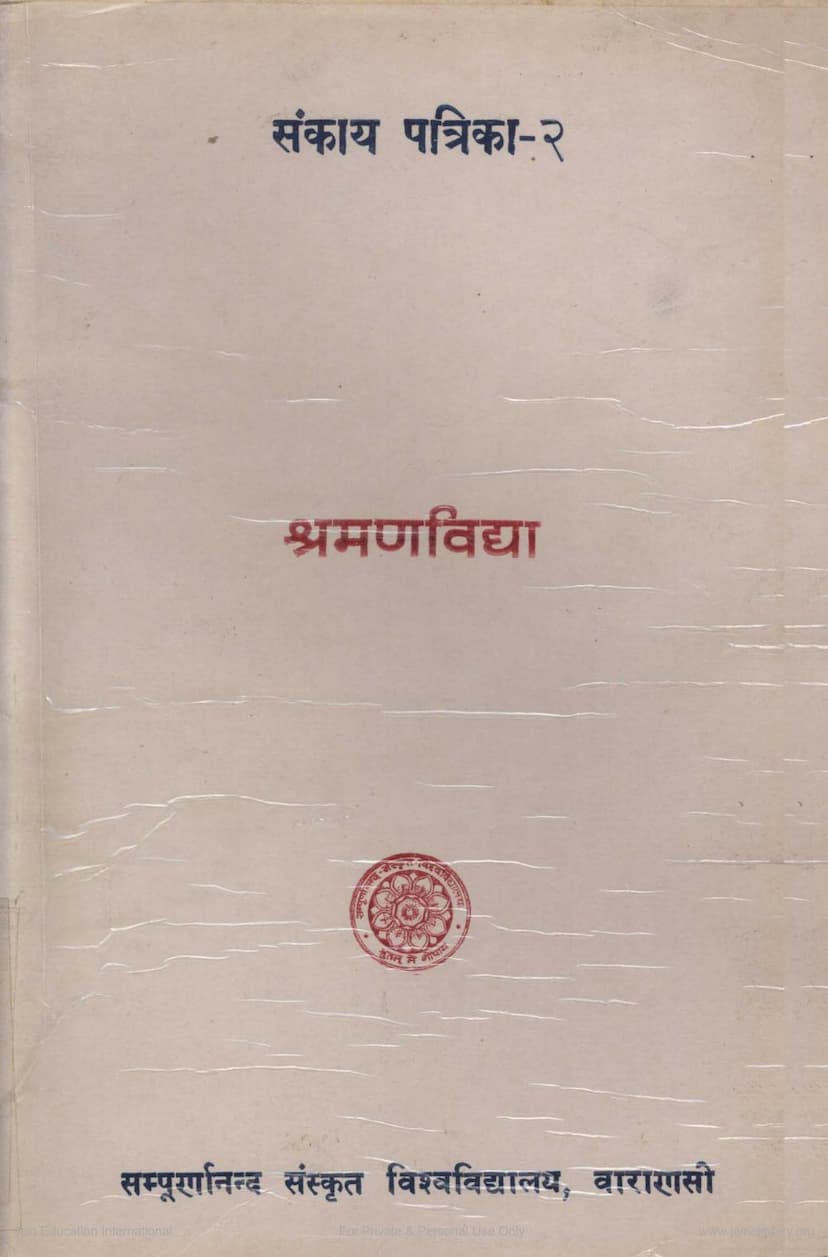Shramanvidya Part 2
Added to library: September 2, 2025

Summary
"Shramanvidya Part 2" is the second volume in the "Shramanvidya" series, published by Sampurnanand Sanskrit Vishvavidyalaya, Varanasi in 1988. Edited by Dr. Gokul Chandra Jain, Head of the Department of Prakrit & Jainagama, this publication is a continuation of research in ancient Indian traditions, specifically focusing on the Shraman (ascetic) traditions.
The volume includes a diverse collection of scholarly works, aiming to shed light on various aspects of Shramanic thought and practice, particularly within the Jain and Buddhist lineages. The content comprises:
-
A special essay titled 'Samvara in Shraman Tradition' by Dr. Kamlesh Jain: This essay delves into the concept of 'Samvara' (restraint or control) as interpreted in both Jain and Buddhist Shraman traditions. It highlights Samvara as a dual journey of inner discipline and outward conduct, ultimately leading to liberation. The essay emphasizes the scientific approach of Indian intellect in understanding Samvara as a means to achieve ultimate spiritual goals like immortality, liberation, or nirvana.
-
Three rare Pali texts in the Devanagari script for the first time:
- 'Simā-Vivāda-Viniścaya-Kathā': Edited by Dr. Brahmadev Narayan Sharma, this text, originally found in Sinhala script, is presented in Devanagari for the first time. It offers insights into the history of Buddhist Vinaya (monastic rules) and is considered valuable for scholars of Pali literature.
- 'Jāti-dukkha-Vibhāgo': Edited by Bhadant D. Somaratana Thero, this text in Pali Gathas is also presented in Devanagari for the first time. It is significant for its division of 'Jāti-dukkha' (suffering of birth) and its description of emptiness in Buddhist philosophy, making it useful for both monks and lay followers, as well as researchers.
- 'Nāma-rūpa-Samāso': Edited by Prof. Ramshankar Tripathi, this text in Pali prose and poetry discusses the 'five skandhas' (aggregates), referred to as 'Nama' and 'Rupa' in Buddhist Abhidharma, highlighting their philosophical importance.
-
An ancient Prakrit Jainagama text:
- 'Kasāya-pāhuḍa-suttaṁ': Edited by Dr. Gokul Chandra Jain and Dr. Smt. Sunita Jain, this text is a Prakrit Agama manuscript dealing with the theory of karma. It is described as a monumental palm-leaf manuscript in ancient Kannada script, believed to be the sole surviving copy globally. This edition, with a Hindi translation, offers new perspectives for research on the doctrine of karma within Jainism. It includes the 'Gāhā-sutta', 'Cūrṇisutta' by Yativrṣabha, and the extensive 'Jayadhavalā' commentary in Prakrit-Sanskrit mixed style. The text is noted for its relevance to the period before sectarian divisions in Jainism.
-
A Prakrit treatise with an unpublished Sanskrit commentary:
- 'Dravya-saṅgraho': Edited by Dr. Gokul Chandra Jain and Shri Rishabhchandra Jain, this popular Prakrit work on the six substances (Sad-dravya) is presented with its commentary, the 'Avacūrī', in Sanskrit, which is published here for the first time. The text focuses on the Jain philosophical discussion of the six substances and 'Pañcāstikāya' (five non-temporal realities), emphasizing its importance in understanding the Jain perspective on the universe and existence.
The editorial board, including Prof. Ramshankar Tripathi, Dr. Phool Chandra Jain, Prof. Laxmi Narayan Tiwari, and Dr. Purusottam Pathak, along with supervisor Dr. Bhagirath Prasad Tripathi 'Vagish Shastri', Director of the Research Institute, and Publication Officer Dr. Harish Chandra Mani Tripathi, have presented a collection of significant texts aimed at furthering the study of Oriental and Shramanic traditions. The publication reflects the university's ongoing efforts in research and academic outreach, including collaborations with international institutions and initiatives in border regions. The editorial expresses deep gratitude for the guiding spirit of Professor Jagannath Upadhyay and acknowledges the contributions of the editorial board, contributing authors, and university administration.